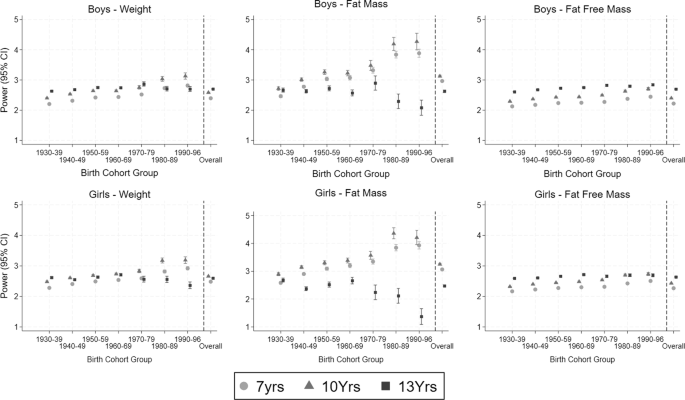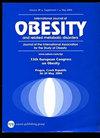Varying optimal power for height-standardisation of childhood weight, fat mass and fat-free mass across the obesity epidemic
IF 4.2
2区 医学
Q1 ENDOCRINOLOGY & METABOLISM
引用次数: 0
Abstract
Childhood adiposity markers can be standardised for height in the form of indices (marker/heightp) to make meaningful comparisons of adiposity patterns within and between individuals of differing heights. The optimal value of p has been shown to differ by birth year, sex, age, and ethnicity. We investigated whether height powers for childhood weight and fat mass (FM) differed by birth year, sex, or age over the period before and during the child obesity epidemic in Copenhagen. Population-based cross-sectional study of 391,801 schoolchildren aged 7 years, 10 years and 13 years, born between 1930 and 1996, from the Copenhagen School Health Records Register. Sex- and age-specific estimates of the height powers for weight and FM were obtained using log–log regression, stratified by a decade of birth. For weight, amongst children born 1930–39, optimal height powers at 7 years were 2.20 (95% CI: 2.19–2.22) for boys and 2.28 (95% CI: 2.26–2.30) for girls. These increased with birth year to 2.82 (95% CI: 2.76–2.87) and 2.92 (95% CI: 2.87–2.97) for boys and girls born in 1990–96, respectively. For FM, amongst those born 1930–39, powers at 7 years were 2.46 (95% CI: 2.42–2.51) and 2.58 (95% CI: 2.53–2.63) for boys and girls, respectively, and increased with birth year reaching 3.89 (95% CI: 3.75–4.02) and 3.93 (95% CI: 3.80–4.06) for boys and girls born 1990–96, respectively. Powers within birth cohort groups for weight and FM were higher at 10 years than at 7 years, though similar increases across groups were observed at both ages. At 13 years, height powers for weight and FM initially increased with the birth year before declining from the 1970s/80s. Due to increases in the standard deviation of weight and FM during the obesity epidemic, optimal height powers needed to standardise childhood weight and FM varied by birth year, sex, and age. Adiposity indices using a uniform height power mean different things for different birth cohort groups, sexes, and ages thus should be interpreted with caution. Alternative methods to account for height in epidemiological analyses are needed.


在肥胖症流行期间,儿童体重、脂肪量和无脂肪量身高标准化的最佳功率各不相同。
简介:儿童肥胖标志物可以通过指数(标志物/身高p)的形式对身高进行标准化,从而对不同身高个体内部和之间的肥胖模式进行有意义的比较。p 的最佳值因出生年份、性别、年龄和种族而异。我们研究了在哥本哈根儿童肥胖症流行之前和流行期间,儿童体重和脂肪量(FM)的身高幂是否因出生年份、性别或年龄而异:基于人口的横断面研究,研究对象为哥本哈根学校健康记录登记册中的 391,801 名 7 岁、10 岁和 13 岁学龄儿童,他们分别出生于 1930 年至 1996 年之间。研究采用对数回归法,按出生年代分层,得出了不同性别和年龄的体重和FM的身高权重估计值:在体重方面,1930-39 年出生的儿童 7 岁时的最佳身高幂分别为:男孩 2.20(95% CI:2.19-2.22),女孩 2.28(95% CI:2.26-2.30)。随着出生年份的增加,1990-1996 年出生的男孩和女孩的身高分别为 2.82(95% CI:2.76-2.87)和 2.92(95% CI:2.87-2.97)。就FM而言,在1930-39年出生的人群中,7岁时男孩和女孩的FM值分别为2.46(95% CI:2.42-2.51)和2.58(95% CI:2.53-2.63),并随着出生年份的增加而增加,1990-96年出生的男孩和女孩的FM值分别为3.89(95% CI:3.75-4.02)和3.93(95% CI:3.80-4.06)。出生队列组内的体重和FM指数在10岁时高于7岁时,尽管在这两个年龄段观察到各组间有相似的增长。在 13 岁时,体重和容积的身高力量最初随着出生年份的增加而增加,然后从 20 世纪 70/80 年代开始下降:结论:由于肥胖症流行期间体重和容积标准偏差的增加,标准化儿童体重和容积所需的最佳身高幂因出生年份、性别和年龄而异。使用统一身高幂的肥胖指数对不同出生组群、性别和年龄的人有不同的意义,因此应谨慎解释。在流行病学分析中,需要采用其他方法来计算身高。
本文章由计算机程序翻译,如有差异,请以英文原文为准。
求助全文
约1分钟内获得全文
求助全文
来源期刊

International Journal of Obesity
医学-内分泌学与代谢
CiteScore
10.00
自引率
2.00%
发文量
221
审稿时长
3 months
期刊介绍:
The International Journal of Obesity is a multi-disciplinary forum for research describing basic, clinical and applied studies in biochemistry, physiology, genetics and nutrition, molecular, metabolic, psychological and epidemiological aspects of obesity and related disorders.
We publish a range of content types including original research articles, technical reports, reviews, correspondence and brief communications that elaborate on significant advances in the field and cover topical issues.
 求助内容:
求助内容: 应助结果提醒方式:
应助结果提醒方式:


